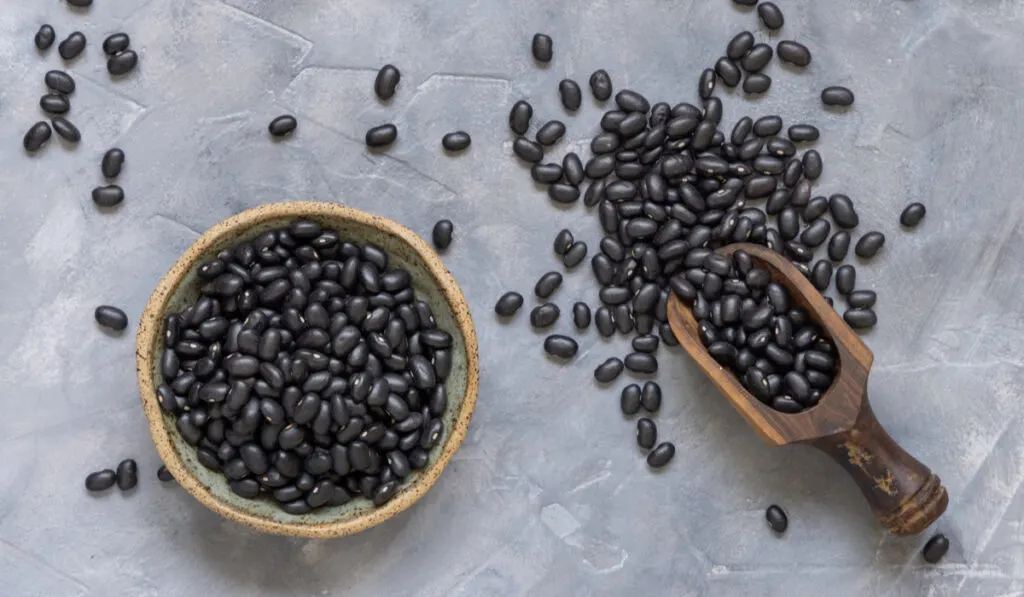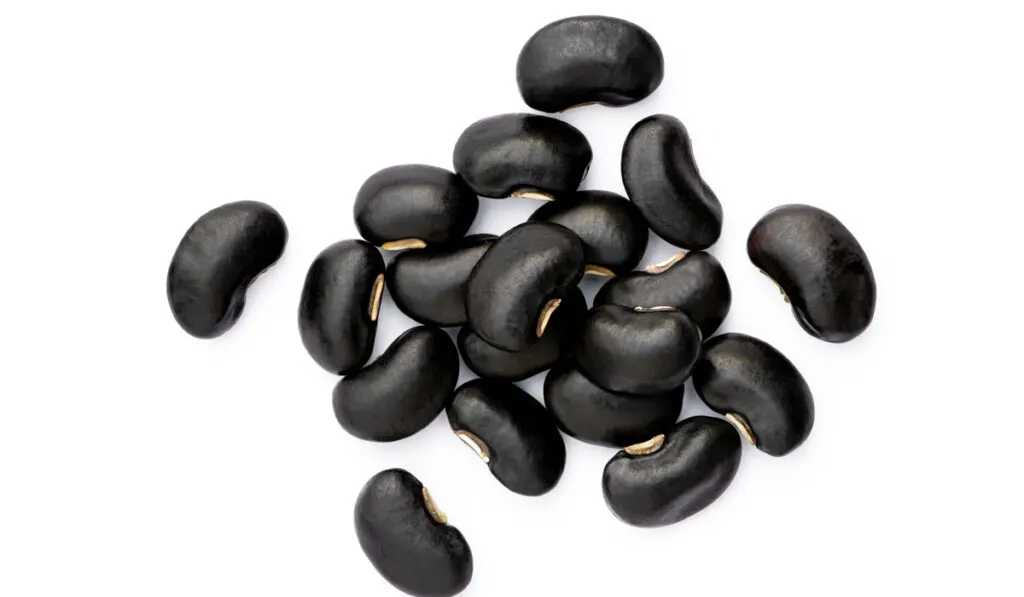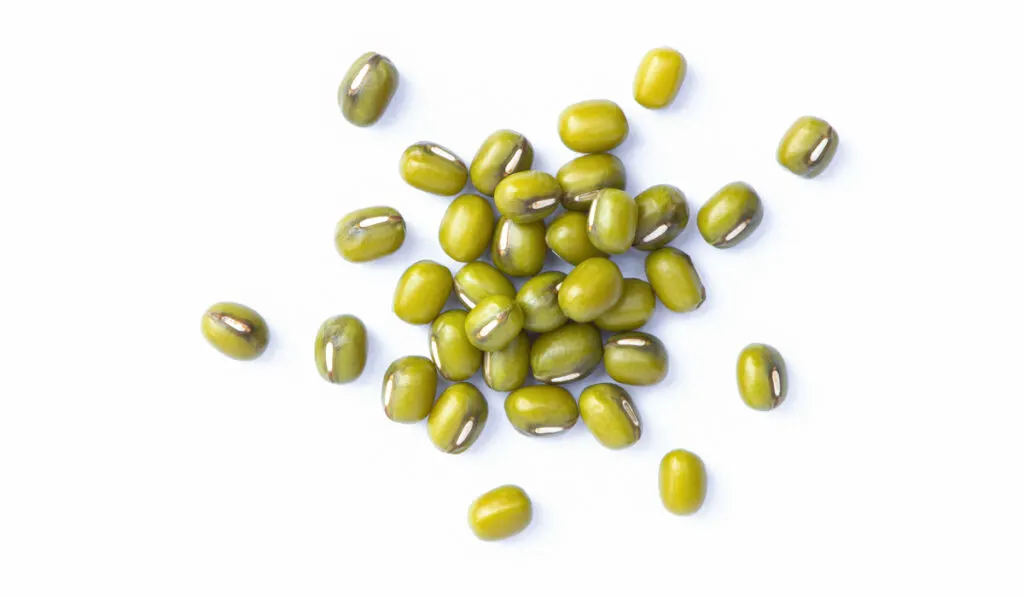If you’re looking to include more protein into your diet but are concerned about eating too much, then you can choose to include beans in your diet.
In fact, these seeds, which come from legume plants in the Fabaceae family, are an ample source of low-calorie and low-fat protein. What’s more interesting is that they are also high in fiber and carbohydrates, making them one of the superfoods.
There are different varieties of beans to choose from. And they might have the same nutrients inside. But what separates one type from another is the appearance, flavor profile, texture, color, and the amount of nutrients you can get from each serving.
With that said, let’s take a look at the top 19 types of beans that you can find out there.
Table of Contents
1. Fava Beans (Vicia faba)

Also known as broad beans, fava beans are commonly used in many dishes in Europe, East Asia, Latin America, and North Africa. These legumes also come as a smaller variety with harder seeds, known as tick beans or field beans.
Fava beans can easily be identified by their large, cushy pods and flat, light green seeds. Although these beans thrive and prosper during colder seasons, try not to plant them in the winter. This is because the seeds still need warm temperatures and enough sunlight to germinate.
Nutritional value per ½-cup serving: 5g protein, 11g carbs, 5g fiber, 55 calories, and 0g fat
Best recipes:
2. Navy Beans (Phaseolus vulgaris)
The origin of navy beans can be traced back several thousand years ago to Peru. These pea-sized beans are also known as “white pea” beans, Yankee beans, and Boston beans.
They can be recognized by their oval shape, small size, and creamy white pods. Navy beans received their name in the mid-1800s because of the way they were served as staple foods in the U.S. Navy.
Cooked navy beans have a soft texture and a mild flavor. They can be mixed with other ingredients without drowning the flavor profile of other ingredients in the dish.
Nutritional value per ½-cup serving: 23g protein, 63g carbs, 16g fiber, 351 calories, and 2g fat
Best recipes:
3. Black Beans (Phaseolus vulgaris)

Black beans originated in South and Central America. These beans are easily recognized by their velvety black shells and mild, creamy flavor. Due to their hard shells, they are also called black turtle beans.
Black beans are sold canned, packaged, or dried. If possible, buy no-sodium canned black beans.
Nutritional value per ½-cup serving: 8g protein, 20g carbs, 7g fiber, 114 calories, and 0g fat
Best recipes:
4. Lima Beans (Phaseolus lunatus)
Also known as butter beans, Madagascar beans, wax beans, and sieva beans, Lima beans are native to Central and South America.
Lima beans come in three different colors: green, white, and cream. They are also categorized into two categories, which are the larger butter beans and the smaller baby lima beans. Baby lima beans have thinner skins compared to mature beans.
Lima beans have a nutty but sweet flavor. With their creamy, soft texture, these beans can turn to mush if they are overcooked.
Nutritional value per ½-cup serving: 5g protein, 16g carbs, 4g fiber, 88 calories, and 1g fat
Best recipes:
Lima Bean Butternut Squash Succotash
5. Red Beans (Vigna angularis)

Red beans are native to the New World, particularly New Mexico and Guatemala. These beans are frequently mistaken for kidney beans, but they are two different varieties.
Red beans can be characterized by their oval shape and small size with glossy, pinkish ruby skin. Meanwhile, kidney beans are much larger with darker, crimson-colored skin.
Red beans also have a softer texture and a mild flavor, with a mix of nutty, earthy, and sweet tastes.
These beans have been used all around the world, including in East Asian, Jamaican, Dominican, North Indian, Cuban, Puerto Rican, and Haitian dishes.
Nutritional value per ½-cup serving: 22g protein, 55g carbs, 23g fiber, 307 calories, and 1g fat
Best recipes:
New Orleans Style Red Bean Rice
6. Garbanzo Beans (Cicer arietinum)
Also known as chickpeas, Egyptian peas, and Bengal gram, the garbanzo bean can be found in two main varieties.
The first variety is common in the United States and can be recognized as the larger and light-colored Kabuli-type.
The second type is the Desi-type, which is often used in the Middle East and India. They can be identified by their dark color, small size, and irregular shape.
Garbanzo beans have a soft texture and nutty flavor. You can use these beans to make hummus, add them to salads, or simply roast them as snacks.
Due to their low glycemic index, people who are looking to reduce a spike in their blood glucose level can switch to these beans for a healthier choice.
Nutritional value per ½-cup serving: 7g protein, 22g carbs, 56g fiber, 135 calories, and 2g fat
Best recipes:
Chickpea Vegetable Coconut Curry
7. Black-Eyed Peas (Vigna unguiculata)

These medium-sized beans are native to Africa. They are also known as cowpeas and as lobia or lobya in the Middle East and Africa. Black-eyed peas can be distinguished by their creamy pale shell and large black, red, or brown spot at the outer center of the shell that resembles an eye.
These beans are slightly heavier and denser than other varieties of the same size. They also have a firm, starchy texture and earthy taste.
In Indian and traditional Southern recipes, black-eyed peas are considered a staple and one of the must-have ingredients that enhance the overall taste of a dish.
Nutritional value per ½-cup serving: 2g protein, 14g carbs, 4g fiber, 65 calories, and 0g fat
Best recipes:
Black-Eyed Pea With Bacon And Pork
Black-Eyed Pea Masala With Kale
8. Soybeans (Glycine max)
Soybeans are native to Eastern Asia and were first harvested by Chinese farmers. They have a light brown to yellow shell with a chewy interior that tastes nutty.
These beans are also one of the common beans that are commercially produced and turned into many products, including soy sauce, soybean oil, soy milk, tofu, soy protein, and soy flour.
There are three types of soybeans that you can find on the market. These include green soybeans (also known as edamame), black soybeans, and the most common type, yellow soybeans.
Nutritional value per ½-cup serving: 6g protein, 5g carbs, 3g fiber, 65 calories, and 3g fat
Best recipes:
9. Great Northern Beans (Phaseolus vulgaris)

Also known as large white beans, Great Northern beans are native to Peru. They came into existence in other parts of the world during Spanish exploration.
Great Northern beans are closely related to kidney beans, have a flat shape similar to lima beans, are slightly larger than navy beans, and are smaller than cannellini beans.
These medium-sized can be recognized by their white hull and delicate, mild flavor. You can also find these beans in soups or stews because of their ability to blend well with the seasonings and ingredients.
Nutritional value per ½-cup serving: 10g protein, 28g carbs, 6g fiber, 149 calories, and 1g fat
Best recipes:
Tomato And White Bean Stew On Toast
10. Lentils (Lens culinaris)
These legumes are native to the Near East and Mediterranean regions and belong in the same family as peas and beans. The majority of lentil production in today’s world happens in Canada and India.
Lentils can easily be recognized by their lens-shaped seeds. And there are two seeds in each pod.
There are a few varieties of lentils including green, brown, and black lentils. Depending on each variety, they would have a different flavor, ranging from sweet to peppery to earthy.
In India, lentils are known as daal. They are often cooked with curry and eaten with roti, naan, and other bread.
Nutritional value per ½-cup serving: 9g protein, 20g carbs, 8g fiber, 115 calories, and 0g fat
Best recipes:
11.Urad Beans (Vigna mungo)

Also known as the black gram, urad dal, and mash Kalai, these beans are native to India and other regions in South Asia. Due to the similarity in size and taste, they are often mistaken for mung beans.
You can buy urad beans in different forms including whole, whole seed, split, and split peeled. Oftentimes, these beans are ground into smaller forms before being mixed with spices and added to a dish.
Nutritional value per ½-cup serving: 24g protein, 60g carbs, 29g fiber, 350 calories, and 1g fat
Best recipes:
12. Pinto Beans (Phaseolus vulgaris)
Pinto beans are native to Mexico. In fact, their name in Spanish means “speckled beans.”
Measuring about a 1/2 inch, these beans can be recognized by their light brown shells, and random, dark speckles found all over their exterior. But when cooked, these beans will turn into a deep pinkish tan.
Pinto beans offer a unique flavor between creamy, earthy, and nutty. Unlike some beans that thrive in cold seasons, pinto beans can only be grown in the summer. They also need at least six hours of sun exposure to grow healthily.
Nutritional value per ½ serving: 21g protein, 60g carbs, 15g fiber, 335 calories, and 1g fat
Best recipes:
Southern Pinto Beans With Ham Hocks
Pinto Beans With Mexican-Style Seasonings
13. Adzuki Beans (Vigna angularis)

Also known as aduki beans and red mung beans, adzuki beans are native to China. They were first brought to Japan around 1,000 years ago before being introduced to other regions in East Asia.
Today, these beans are grown in many countries including Korea, the Philippines, India, Thailand, Taiwan, and New Zealand.
Adzuki beans can be recognized by their red skin and plump shape. They also come in other varieties such as black, white, gray, and mottled. Due to their sweet and nutty taste, these beans are popular in East Asian dishes, soups, and dumplings.
Nutritional value per ½-cup serving: 6g protein, 81g carbs, 0g fiber, 351 calories, and 0g fat
Best recipes:
Mushroom Lentil Adzuki Bean Soup
14. Kidney Beans (Phaseolus vulgaris)
Commonly mistaken for pinto beans and adzuki beans, kidney beans are one of the common bean varieties that hail from Central America and Mexico. Like their name, kidney beans resemble the shape of a human kidney.
Aside from the red variety, these beans also come in other colors including white, green, black, purple, cream, mottled, spotted, and striped. After they’re cooked, kidney beans yield a mild and sweet flavor and creamy, tender texture.
To get the best taste and texture out of kidney beans, be sure to soak them in water overnight or at least between 4 and 5 hours before cooking them.
Nutritional value per ½-cup serving: 22g protein, 55g carbs, 23g fiber, 307 calories, and 1g fat
Best recipes:
15. Mung Beans (Vigna radiata)

Mung beans are native to India, but they have been widely cultivated in other regions including China, South East Asia, Africa, Australia, and South America. These beans are also called golden gram, green gram, Jerusalem peas, and celera beans.
Mung beans are small and green in color. When cooked, they have a tender texture with a mild but slightly sweet flavor. These beans can be turned into different products including mung bean wine, cake, noodles, pastes, and flour.
Eating this protein and carbohydrate-rich bean can offer a lot of benefits to your health. They are also high in other nutrients such as magnesium, potassium, vitamin B, and folate.
Nutritional value per ½-cup serving: 25g protein, 65g carbs, 17g fiber, 359 calories, and 1g fat
Best recipes:
Fire Roasted Tomato And Mung Bean Soup
16. Anasazi Beans
Anasazi beans are native to Central America. They were commonly cultivated in the early 1900s by the Anasazi people that lived in Colorado, Utah, Arizona, and New Mexico.
As such, these beans are also known as Aztec beans, Jacob’s Cattle beans, New Mexico appaloosas, and New Mexico cave beans.
Anasazi beans can be recognized by their small size, kidney-like shape, and white skin with irregular speckles found on the exterior. They’re about the size of small pinto beans but slightly larger than black beans. These beans also have a nutty, earthy, and sweet flavor profile.
Nutritional value per ½-cup serving: 22g protein, 60g carbs, 26g fiber, 340 calories, and 2g fat
Best recipes:
New Orleans-style Anasazi Bean And Rice
17. Borlotti Beans (Phaseolus vulgaris, Cranberry Group)

Borlotti beans can be commonly found in Mexico, Italy, and Portugal, but they were first bred in Colombia as cargamanto.
They are also known as cranberry beans because these beans can be recognized by their light, beige-pink hull, and red-brown speckles all over the exterior. They also have a creamy and savory flavor.
Borlotti beans are usually sold shelled or dried. Unlike dried Borlotti beans, fresh Borlotti beans should be shelled and don’t need to be soaked with water. However, they might cost more than the dried ones.
Nutritional value per ½-cup serving: 7g protein, 20g carbs, 8g fiber, 108 calories, and 0g fat
Best recipes:
Turkish-Style Borlotti Beans (Barbunya Pilaki)
Borlotti Beans With Garlic And Olive Oil
18. Flageolet Beans (Phaseolus vulgaris, Flageolet Group)
Also known as fayot beans, flageolet beans are native to France and used as popular ingredients in many French cuisines.
These beans can be distinguished by their small size, kidney-like shape, and light green shell. To retain their fresh, green color, they are picked before maturity and dried in the shade.
Flageolet beans have a unique flavor profile somewhere between sweet, creamy, nutty, and mellow tasting notes. In the United States, they are widely grown in California. These beans also come in other colors including red, white, yellow, and black.
Nutritional value per ½-cup serving: 10g protein, 28g carbs, 11g fiber, 184 calories, and 4g fat
Best recipes:
Lamb Stew With Flageolets And Herbs
Flageolet Beans With Rosemary And Thyme
Final Thoughts
Today there are more than 400 varieties of edible beans recorded and found in many parts of the world. There are so many recipes that you can use to cook your favorite beans and turn them into delicious dishes. It all depends on your creativity and the way you incorporate other ingredients into the dishes.
Not to mention, if you don’t have the time, you can just simply boil, fry, or even roast most of these beans and eat them as your go-to snacks.
Citations
- https://www.purewow.com/food/types-of-beans
- https://facts.net/types-of-beans/
- https://www.jessicagavin.com/types-of-beans/
- https://www.thespruceeats.com/what-are-fava-beans-995664
- https://whfoods.com/genpage.php?tname=foodspice&dbid=88
- https://en.wikipedia.org/wiki/Black_turtle_bean
- https://www.thespruceeats.com/what-are-butter-beans-5105145
- https://randallbeans.com/2020/03/05/difference-between-kidney-beans-red-beans-pinto-beans/
- https://www.hsph.harvard.edu/nutritionsource/food-features/chickpeas-garbanzo-beans/
- https://kidadl.com/fun-facts/are-black-eyed-peas-beans-what-are-they-classified-as
- https://www.britannica.com/plant/soybean
- https://woodlandfoods.com/products/great-northern-beans/c-23/p-15105
- https://www.thespruceeats.com/history-of-lentils-1807624
- https://en.wikipedia.org/wiki/Vigna_mungo
- https://woodlandfoods.com/products/pinto-beans/c-23/p-11017
- https://specialtyproduce.com/produce/Flageolet_Shelling_Beans_10894.php
- https://www.feedipedia.org/node/235
- https://www.thespruceeats.com/what-are-borlotti-beans-5079142
- https://www.delightedcooking.com/what-are-anasazi-beans.htm
- https://www.finecooking.com/recipe/lamb-stew-with-flageolets-and-herbs
- https://www.finecooking.com/recipe/new-orleans-style-anasazi-beans-and-rice
